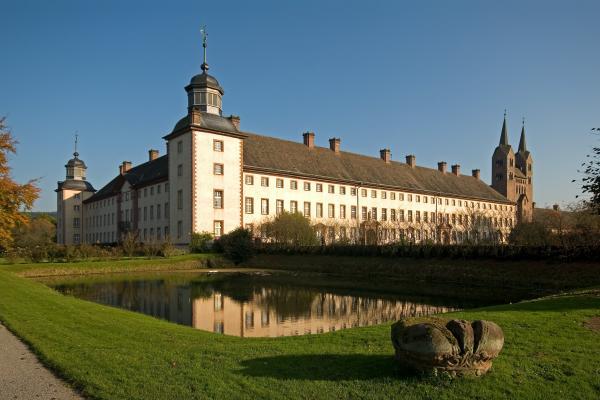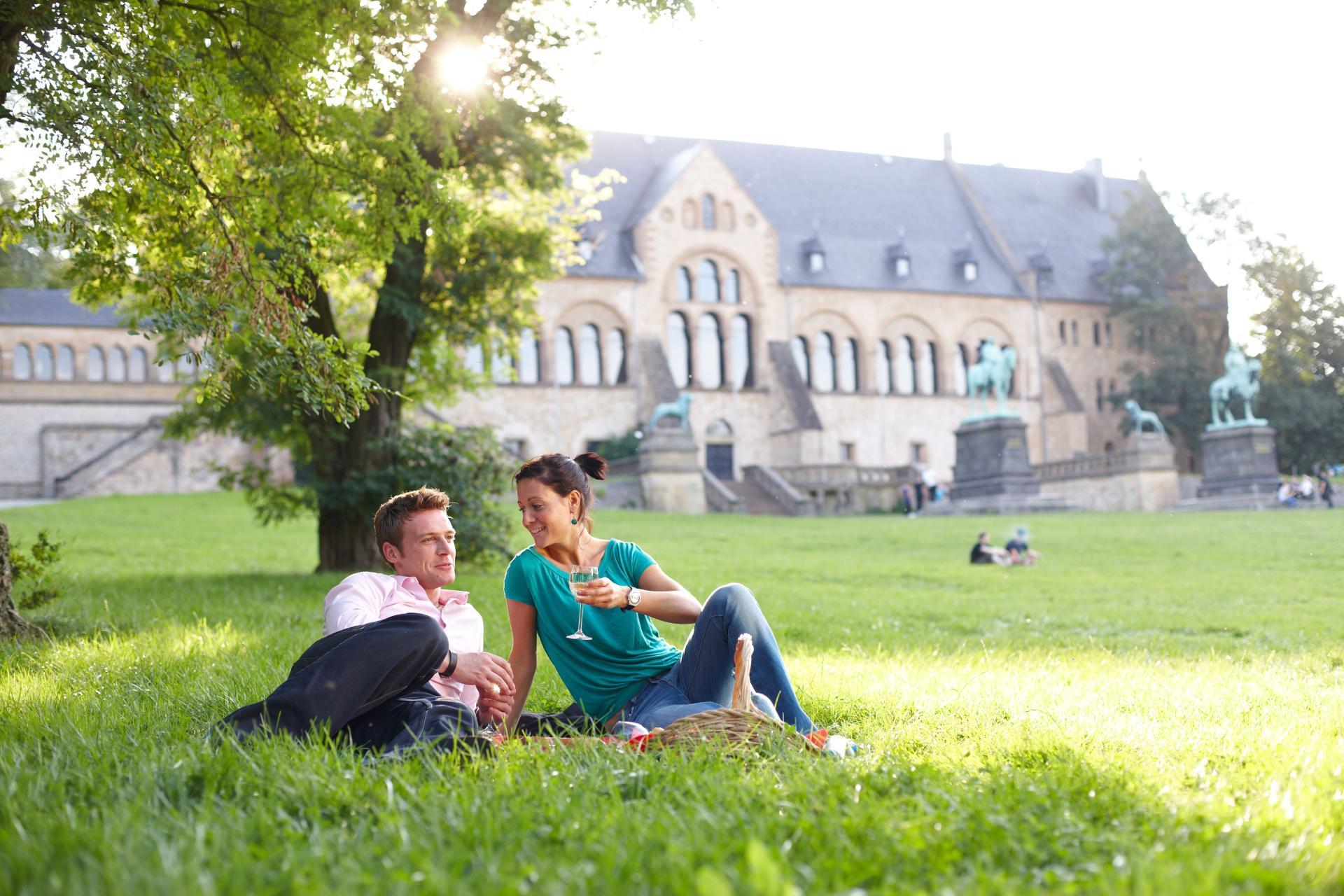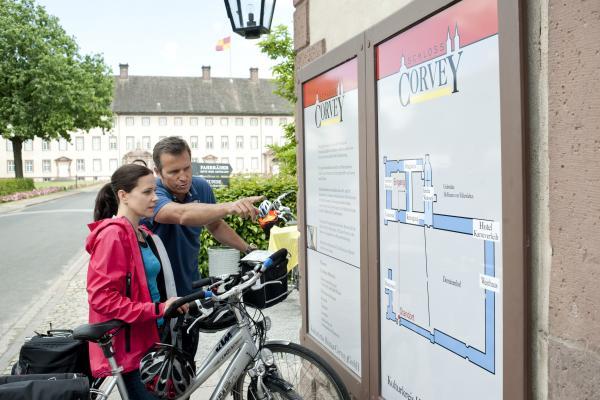Along the ridges of the historically significant Teutoburg Forest, one enjoys a magnificent view over the Lippe region, also known as the Land of Hermann. Near Detmold, atop the densely wooded Grotenburg, stands the Hermann Monument (1875), Germany's tallest statue and a symbol of national unity aspirations in the 19th century. It commemorates the famous Battle of the Teutoburg Forest in 9 AD, where the Germanic tribes decisively defeated the Roman legions.
Further along the route, the path descends into the legendary Weser Uplands with its gentle hills. You pass by the former Benedictine monastery, now a World Heritage site called Corvey, and impressive castles in the Weser Renaissance style, which developed from the early 16th to the mid-17th century. Situated directly on the R1 route, Bevern Castle delights with its magnificent facade adorned with curved gables and rich ornaments. The inner courtyard showcases an elaborate bay window (Utlucht) and two stair towers. These are all stylistic features that emerged regionally under the influence of Italian and Western European Renaissance. In addition to princely castles, representative churches, town halls, and houses of citizens and farmers bear witness to the prosperity of the region.
Starting with the vintage car, half-timbered, and beer town of Einbeck, the impressive cities of timber-framed art come to life. While cycling, you experience the character-defining presence of half-timbered houses, reflecting various European architectural styles. Passing through Bad Gandersheim with its historically significant Romanesque collegiate church, you continue along the northern edge of the Harz Mountains to Goslar. This city captivates cyclists with its UNESCO World Heritage ensemble of over 1,500 half-timbered houses from different eras, the Rammelsberg Visitor Mine, and the Oberharz Water Management system, leaving visitors in awe!
Your highlights on this culture story

Baroque castle and monastery complex of Corvey
The medieval westwork of the abbey church in the castle and monastery complex of Corvey is the oldest preserved building in Westphalia and an important testimony to the Carolingian Renaissance. In 822, Charlemagne had the Benedictine abbey built outside the gates of Höxter, and it has a history of almost 1000 years of monastic life. Today, the baroque castle complex, with its famous Imperial Hall, historic cloister, and the highly extensive Princely Library with 75,000 volumes, is privately owned by the ducal family and has officially been part of the UNESCO World Heritage site since 2014.
Events such as the Corvey Summer Concerts featuring renowned national and international ensembles and soloists attract visitors from all over the world. The Garden Festival, Via Nova Art Festival, and various themed guided tours are also highly popular among guests from both within and outside the country.

The Hermann Monument
The famous colossal statue was constructed according to designs by Ernst von Bandel, who dedicated his entire artistic career to it. It took a staggering 37 years for the monument, with a total height of 53.56 meters, to be inaugurated on Grotenburg in 1875. The Hermann Monument commemorates Arminius, the Cheruscan chieftain who decisively defeated the Roman legions under Publius Quinctilius Varus in the Teutoburg Forest in 9 AD, thereby preventing further expansion of the Roman Empire to the north. However, the actual site of the battle is now believed to be in the Kalkriese region in Osnabrück Land. The figure of Hermann embodies the pursuit of a new national consciousness in politically fragmented Germany following the Napoleonic Wars. Today, it is considered a universally recognized national symbol while simultaneously affirming commitment to a liberal order, attracting over 500,000 visitors from around the world annually.

Old town Goslar
It was the Rammelsberg ores that established the wealth of the city of Goslar. Impressive buildings such as the Imperial Palace, one of the largest hall structures in Germany and now the city's landmark, attest to the significance of mining, which you can familiarize yourself with at the Rammelsberg Museum and Visitor Mine, with its thousand-year history. The historic structures from different eras, over 1500 half-timbered houses, and many picturesque alleys within the former city walls form the historic center of Goslar, which, together with the Oberharz Water Management system and the Rammelsberg, has been declared a UNESCO World Heritage site. A special highlight is the carillon in the gable of the Kämmereigebäude on the marketplace, which recounts the city's history. The town hall also houses an information center providing an overview of UNESCO World Heritage sites and many details about the Harz region's World Heritage status.
Do not miss!

Beer city Einbeck
Despite its remote location between the low mountain ranges of the Weser Uplands, Harz, and Solling, Einbeck is well-known far beyond the borders of the region. There were more than 700 breweries here, and their tall gateways for the brewery wagons can still be found in many parts of the cityscape. The brewing tradition dates back to the 14th century. In 1368, the city joined the Hanseatic League and elevated beer to an international commodity. The richly adorned facades of the half-timbered houses reflect the former prosperity of the brewing citizens, whose naturally cloudy Bock beer specialty was exported from Scandinavia to the foothills of the Alps and is still produced today in the Einbecker Brauhaus. Naturally, according to the old recipe! In the beer exhibition at the City Museum, you can see it for yourself and also marvel at the oldest beer barrel in Europe.
Regional products along the cultural history

Because home has meaning
As diverse and unique as the region itself are the products made by the local, mostly family-run businesses. Whether it's culinary delights, traditional crafts, or extraordinary and unusual items, the "Echt! - Solling-Vogler Region" label bundles regional products of the highest quality that must meet defined criteria and undergo verification by a quality committee:
Some of the criteria include:
- The provider is based in the Solling-Vogler region and manufactures their products within the region.
- The production of the product utilizes raw materials from the Solling-Vogler region.
- The product is regionally characteristic, of high quality, and unique.
- The provider demonstrates responsible use of resources in the production process.
- The businesses of Echt! providers are identified with the golden logo.
The highlights along the route
Our daily stage recommendation
Etappe Detmold-Höxter
Die sportliche, oft von Bächen und Flüssen begleitete Etappe ermöglicht Begegnungen mit großen Statuen und Adlern auf Bergen, Mythen und Legenden am Waldsee, Fröschen und Wasserbüffeln in Tongruben, Käse und Schinken in der Börde und Fachwerk und Weltkultur am Fluss.
Etappe Höxter - Einbeck
An der Weser beginnend radeln Sie auf dieser Etappe des R1 etwa 60 km, vorbei am Rande des Naturparks Solling-Vogler, durch das Leinetal bis in die Bier- und Fachwerkstadt Einbeck.
Etappe Einbeck-Goslar
Einmal mehr verändert sich die Landschaft um die Radfahrer herum, denn der Europaradweg nimmt nun Kurs auf den Harz. Am Rande des Mittelgebirges lassen sich ein paar tolle Ausblicke etwa auf die Innerste oder die Granetalsperre erhaschen, bevor die siebte Etappe des Radfernwegs im schönen Goslar...



